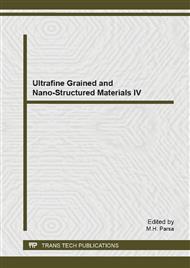p.25
p.30
p.36
p.41
p.46
p.52
p.57
p.62
p.67
Preparation of Shaped Carbon Nanotube Composites with Porous Structures
Abstract:
Porous structures of carbon nanotube (CNT) composites with highly accessible surface areas have numerous potential applications such as heterogeneous catalysts and adsorbents. In this study sodium alginate was added to CNTs dispersions as gelling agent. Before being dried, the hydrogels were shaped into bead, disk, and sheet forms. The alginate in the composites was then decomposed by heating up the samples under an inert gas. The morphology of the as-prepared composite was studied by scanning and transmission electron microscopy and the pore size distribution was measured by BJH method. The MWCNT composite showed a density of around 0.08 g/cm3 and a specific surface area of 164 m2/g. The as-synthesized porous composite was examined as an adsorbent to remove methylene blue (MB) from aqueous solutions. Complete removal of MB was observed. The adsorption isotherm and kinetics were also evaluated.
Info:
Periodical:
Pages:
46-51
Citation:
Online since:
November 2013
Authors:
Keywords:
Price:
Сopyright:
© 2014 Trans Tech Publications Ltd. All Rights Reserved
Share:
Citation:


